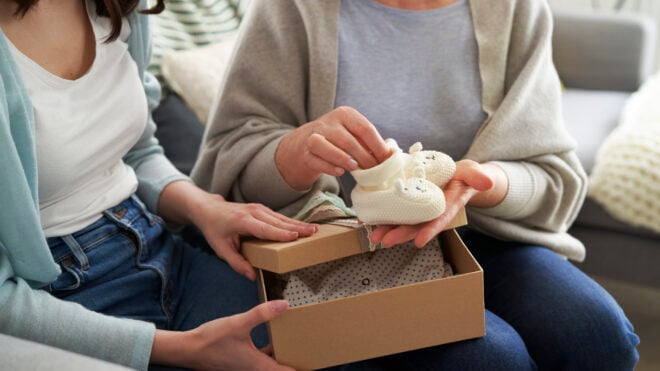
*Disclaimer: The advice on Mom.com is not a substitute for consultation with a medical professional or treatment for a specific condition. You should not use this information to diagnose or treat a health problem without consulting a qualified professional. Please contact your health-care provider with questions and concerns.
For those nearing the end of their third trimester, or even surpassing their due date, it can feel like the baby is taking so long to join the world. At this point, you’ve been pregnant for what feels like forever, and you may be interested in trying to induce labor at home.
There are a lot of old wives’ tales and myths about how to jump-start the process. From certain foods to eat that help induce labor to exercises and messages to try, there are a lot of theories. But here’s the lowdown on which ways are scientifically tested and may be proven to help, and which are just wishful thinking.
More from Mom.com: Expensive Baby Products That Are Actually Worth It
When to Even Start

Although pregnancy is a long journey, it really is important to let your baby develop as much as they can before you try any potential induction methods at home. Certified nurse-midwife Melodee Babcock told Henry Ford Health that “we usually tell people not to do anything until they’re 39 weeks.”
Even at that point, it’s definitely a conversation to have with your doctor before you explore any old wives’ tales.
Can Certain Foods Induce Labor?

There are old wives’ tales about eating pineapple or drinking raspberry leaf tea to induce labor. But Nebraska Medicine reported that neither of these myths are rooted in any real science.
“Until there’s more safety data, I don’t necessarily recommend it for labor induction,” certified nurse-midwife Alyssa Fischer told Nebraska Medicine.
Dates May Be Effective

According to Nebraska Medicine, some research has found that eating dates may help produce “more effective contractions.” Alyssa Fischer added that most of the studies recommended eating around four large dates with pits or six to 10 small pitted dates daily, beginning around 37 weeks. That’s provided you don’t have any diabetic issues, though, since dates are high in sugar.
More from Mom.com: Why (and How) You Should Eat Your Placenta
Licorice Has Also Been Studied

A study of 1,049 Finnish women published in the American Journal of Epidemiology in 2001 found that those who ate high levels of licorice “were significantly more likely” to have their babies born earlier. One study from decades ago doesn’t necessarily mean this is a foolproof method. But expectant parents can try it if their doctors agree that it’s safe.
Castor Oil & Spicy Foods

Castor oil has laxative properties, and since it “triggers bowel movements, it may also stimulate the uterus, leading to contractions,” per VeryWell Health. However, VeryWell cautioned that taking too much castor oil can potentially harm the baby as well as cause nausea, vomiting, or diarrhea. Only take castor oil under the care and advice of a doctor.
Special Restaurant Meals

According to Food & Wine, a number of restaurants across the country boast that their menus contain items that can induce labor. These are anecdotal findings at best (and pretty much just marketing promotions). Interested in trying one near you? The main ones are the salad at Caioti Pizza Cafe in Studio City, California; the shrimp quesadilla at Las Margaritas in Gainesville, Florida; and the pizza at Hawthorne’s New York Pizza and Bar in Charlotte, North Carolina.
Using an Exercise Ball Can Help

Per The Birth Center of New Jersey, gently bouncing on an exercise ball can help to open your pelvis. This encourages the baby to move lower and contractions to start. Use it throughout labor as an active alternative to lying down while contractions are ongoing.
Try These Exercise Ball Moves

The Birth Center of New Jersey said that two potentially helpful prenatal exercises to do with the ball are figure eights and squats.
The figure eight: Sit on the ball, feet flat on the ground, and gently circle your hips around in a figure eight movement. The birth center noted that this can help the baby move into birth position and loosen your pelvic muscles.
Squats: Place the ball against the wall. Then, lean against the ball with your back and squat while keeping your feet shoulder-width apart. This can help strengthen your pelvic and leg muscles prior to labor.
Walking Can Help

There’s no extensive research on whether walking itself can induce labor, per The New York Times. But anecdotally, many have claimed that it can help. But there was a study published in 2021 in the Journal of Education and Health Promotion that found that walking could contribute to “a more prepared cervix” by the time the person was admitted for labor.
Try Curb Walking

Curb walking is when you walk along the sidewalk with one foot on the curb level and one on the street level. Like regular walking, it’s not proven to necessarily induce labor. But it may help if you’ve already started dilating, according to Ochsner Health. “Theoretically, the unequal walking pattern created by the curb causes the pelvis to open and allows the baby’s head to descend,” the site reported.
Only do this walk for about 10 minutes.
Acupressure Can Aid Before and During Labor

Acupressure is a type of Chinese massage therapy that focuses on specific pressure points on the body. It can help “alleviate pain and shorten labor,” according to UCI Health. But you can start the massages before labor begins as well.
Gynecologist and obstetrician Dr. Donna G. Baick told UCI Health that you can start these messages once the pregnancy has reached full term and mild contractions may have begun. Use a lighter touch until active labor has started.
Pressure Points

Per Yo San University, the pressure points to focus on are as follows:
- Between the pointer finger and thumb on the back of your hand.
- About four fingers above the ankle on the inner leg.
- Behind the ankle on the outer leg, in the indentation by your Achilles tendon.
- The trapezius muscle above the shoulders by your neck.
- Above the pubic bone on your lower belly.
Because these pressure points can stimulate contractions, consult with a doctor before trying acupressure.
Acupressure May Also Help Avoid C-Sections

Per Healthline, a 27-study review found that using acupressure helped to reduce the chances that a person would need to deliver via C-section. It could be worth exploring as a pain management solution during labor, especially for those who wish to give birth vaginally.
Acupuncture Could Work, Too

Acupuncture applies a similar methodology as acupressure, but with needles inserted into pressure points. Per a 2024 study published in the American Journal of Obstetrics & Gynecology MFM, those who had acupuncture four days prior to their scheduled labor inductions had an increase in “spontaneous onset of labor.”
As with acupressure, consult with a doctor before trying acupuncture.
Sex and Stimulation

According to Healthline, sexual activity can help to ripen the cervix and release oxytocin, which can jump-start contractions. But is it a proven method? There are studies on both sides of this issue. Some have found connections between delivering sooner and engaging in sexual activity, while others found no large connection.
As always, consult with your doctor if you have induction concerns.







